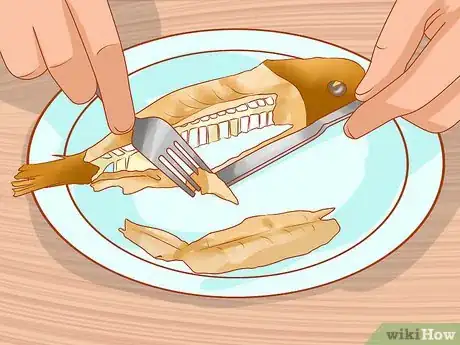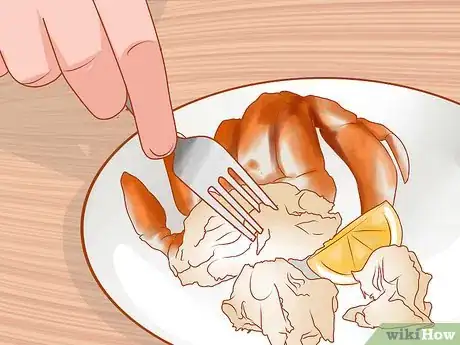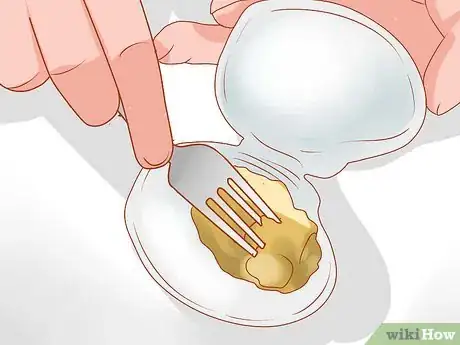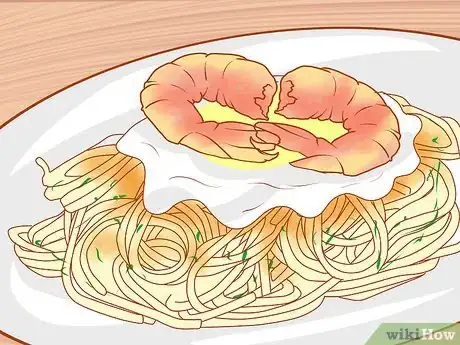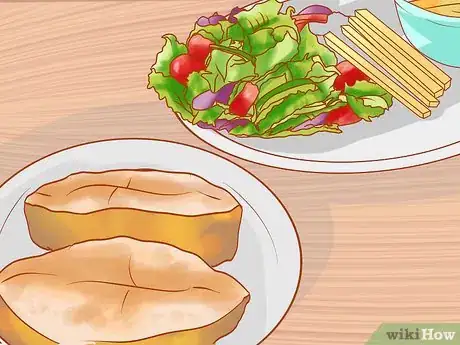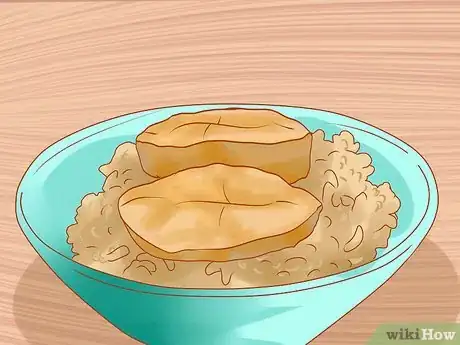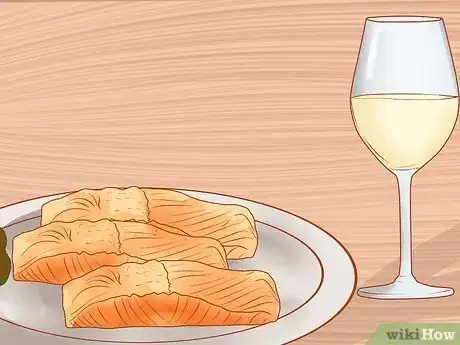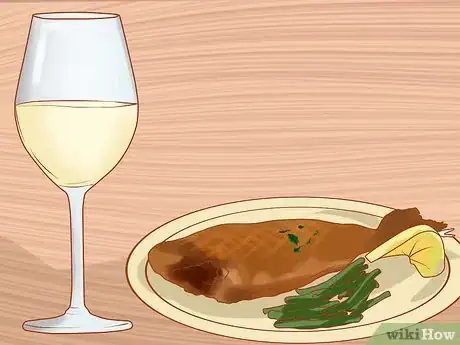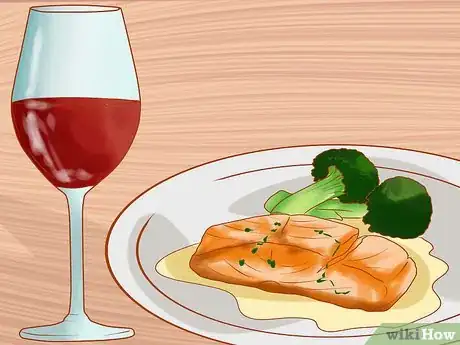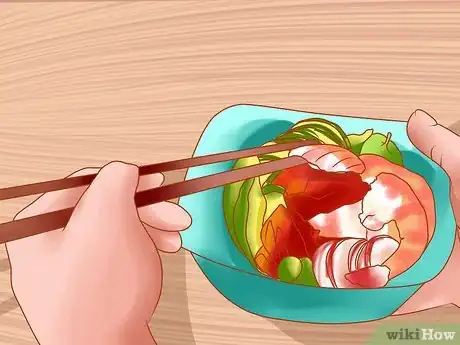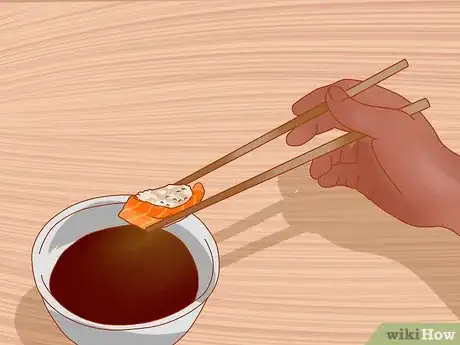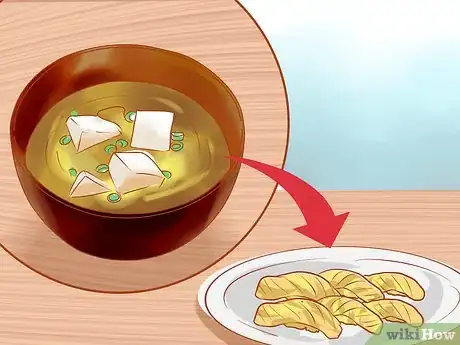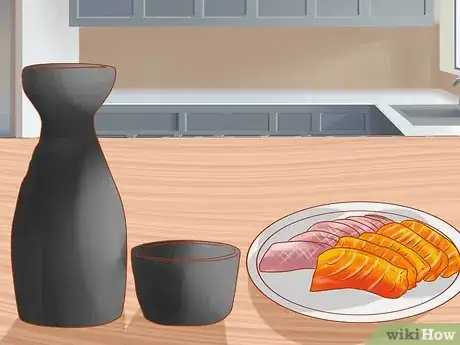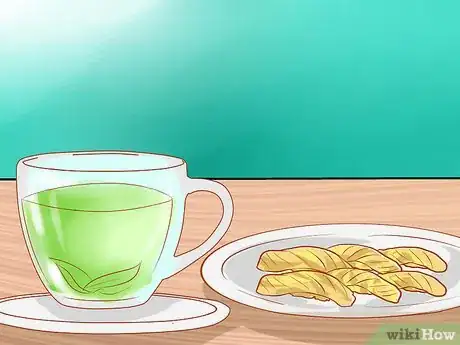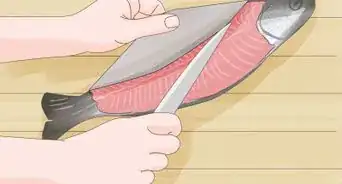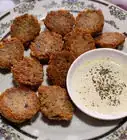This article was co-authored by wikiHow Staff. Our trained team of editors and researchers validate articles for accuracy and comprehensiveness. wikiHow's Content Management Team carefully monitors the work from our editorial staff to ensure that each article is backed by trusted research and meets our high quality standards.
This article has been viewed 75,115 times.
Learn more...
Fish can be included in your weekly diet, and eaten at least three times a week. Not only is fish low in calories it is also a great source of proteins, vitamins and minerals, and Omega-3 oils, all of which are good for maintaining a healthy body and mind. There are many ways to prepare fish to make it more interesting to eat, even for those who are not great fish lovers.
Steps
Eating Fish and Other Seafood
-
1Fillet and de-bone whole fish before eating it. If the fish is being served whole, you'll want to cut the head off first, just behind the gills. Next, hold the body with your fork, and use your knife to the belly open, starting at the head and ending at the tail. Pull open the body, and remove the backbone. You can do this by placing the tip of your knife under the spine, then lifting it out with your fork.[1]
- If you can't remove the bones, simply eat around them. Don't flip the fish over to eat the flesh from the other side of the bones. This is bad etiquette. Instead, use your fork to lift the bone up and pull the flesh away.
-
2Eat fish fillets and steaks with a fork and knife. Most fish fillets will be de-boned, but you will still want to be careful. If you bite into a bone, simply pull it out of your mouth with your fingers, and set it down onto the side of your plate.
- Some people like to eat the skin of their fish. Other people like to peel it away first using a fork and knife.
Advertisement -
3Don't eat the shell, vein, tail, or head on shrimp or prawns. If you ordered pasta, likely the shrimp and prawns will already come peeled and deveined. If you ordered them as a dish, they may come whole. In this case, you'll need to the pull off the head and tail, then the shell. Be sure to pull out the black thread along the back and discard it before eating the shrimp or prawn.
- To eat a peeled and headless prawn or shrimp: grip it by the tail, bite the body off, and discard the tail.
- When peeling shrimp, it is easiest to start from the underside of the body, where the legs are.
-
4Eat crab and lobster directly from the shell with a fork. Crack the claws and legs with special cracker, then pull meat out with fork or pick. Some restaurants will also offer to serve the meat already extracted from the shell for you.
-
5Use a fork or shell to pull the flesh away from clams and mussels. When eating a bowl of clams or mussels, see if you can find an intact shell, then use it to grip and pull the fleshy bits from the shells. You can also use a fork instead, if you'd like.
Serving and Pairing Fish
-
1For something classic, pair fish and seafood with pasta or spaghetti. Seafood, such as shrimp or scallops, go especially well with spaghetti. Tuna goes well with alfredo sauce and pasta.
-
2For something easy, pair fish, especially fried fish, with potatoes.[2] You can also pair fish fried in breadcrumbs with fries/chips for a typical "fish and chips" pairing.
-
3For something refreshing or simple, pair fish and seafood with salads or steamed vegetables. Caesar salad goes well with pasta and shrimp or scallops, and bean salad is great when paired with tilapia. Steamed vegetables are also an excellent choice. You don't have to worry about adding any fancy sauces or oils.[3] A little bit of seasoning, such as salt and pepper, will be plenty.
-
4Try fish with brown rice or quinoa for extra fiber. Quinoa is full of fiber, iron, magnesium, phosphorous, potassium, and vitamin B. It goes well with just about any type of fish. Brown rice is an excellent source of fiber, and goes well with salmon, especially miso-glazed salmon.[4]
-
5Pair lean, flaky fish with zesty, refreshing white wines. Delicate fish, such as sea bass, flounder, sole, and tilapia, need a delicate white wine for balance. Consider white wines from the South of France, Greece, or Portugal. Lean, flaky will also go well with wines like Champagne, Chardonnay, Pinot Grigio, and Sauvignon Blanc.[5]
-
6Pair medium-textured flakey fish with medium-bodied white wines. Consider wines that are rich in aromas, or aged in oak. Fish like trout, catfish, cod, and halibut go well with wines like Chardonnay, Sauvignon Blanc, and Pinot Gris.[6]
-
7Pair firm, meaty fish with rich, flavorful white wines, and some red and rosé wines. Fish like salmon, mackerel, mahi mahi, shark, swordfish, or tuna have a firm texture, almost like steak. They go best with rich wines, such as: Chardonnay, Dry Rosé, Sauvignon Vert, and vintage Champagne. They also go well with Pinot, such as White Pinot Noir and Pinot d’Alsace.[7]
-
8Pair salty, strongly flavored fish with mostly red wines. Fish like anchovies, sardine, herring, and mackerel need a strong wine, but will also go well with Champagne. Consider any of the following wines: Champagne, Dry Rosé, Pinot Noir, and any Greek red wines.[8]
Serving and Pairing Raw Fish and Sushi
-
1Enjoy Eat Sushi for lunch or dinner. You can eat it at sushi bars, or you can prepare it yourself. If you choose to prepare it yourself, make sure that you buy sushi-grade raw fish, as the standard fish sold at the super market may not be fresh or flavorful enough.
-
2Eat sushi with a pair of chopsticks. You can eat nigiri sushi with your fingers, but sashimi should only be eaten with chopsticks. Nigiri sushi looks like little pieces of fish served in little bricks made of rice. Sashimi is thin slices of raw fish.
- Try to eat nigiri sushi in one bite. This may be more challenging in Western countries, where nigiri is usually made larger.
-
3Always dip nigiri sushi fish-side-down into the soy sauce. Never dip it rice-first into the soy sauce. The rice will soak up too much sauce, and it may fall apart. The last thing you'd want is a bunch of rice grains in your soy sauce.
-
4Consider serving a bowl of Miso soup before the sushi. Miso soup complements the delicate flavor of sushi well. It is usually drunk straight from the bowl.
-
5Be mindful of the pickled ginger and wasabi. Use pickled ginger as a palate cleanser between bites of sushi; don't eat it all in one bite. Also, don't mix wasabi into the soy sauce. The chef will already have placed what he feels to be the right amount into the sushi before serving it. If you want that extra spice, slip a little bit of wasabi under the sushi with the tip of your chopstick.[9]
-
6Save the sake for before or after the meal. If you must enjoy your sake with your meal, consider pairing it with sashimi instead of nigiri. Both sake and nigiri are rice-based. Many people feel that this will create a poor balance.[10]
-
7Enjoy sushi with a cup of green tea. It works well with both nigiri and sashimi type sushi.[11]
References
- ↑ http://www.etiquettescholar.com/dining_etiquette/table_manners/dinner_etiquette/seafood/fish.html
- ↑ http://thehealthyfish.com/7-best-side-dishes-to-serve-with-fish/
- ↑ http://thehealthyfish.com/7-best-side-dishes-to-serve-with-fish/
- ↑ http://thehealthyfish.com/7-best-side-dishes-to-serve-with-fish/
- ↑ https://winefolly.com/tips/wine-with-fish-pairing-guide/
- ↑ https://winefolly.com/tips/wine-with-fish-pairing-guide/
- ↑ https://winefolly.com/tips/wine-with-fish-pairing-guide/
- ↑ https://winefolly.com/tips/wine-with-fish-pairing-guide/
- ↑ http://www.sushifaq.com/basic-sushi-experience-information/how-to-eat-sushi-sushi-etiquette/
About This Article
If you want to eat a fish that is being served whole, cut its head off first, just behind its gills. Then, cut the belly open from its head to its tail, and peel the fish open. Pry the backbone out with a fork if you can, or peel the flesh off of the bones with a fork. Either way, leave the belly of the fish up because turning it over is bad etiquette. Eat de-boned fillets with a fork and knife, with or without the skin. Keep reading to learn how to eat shrimp, and what foods you should pair seafood with.
